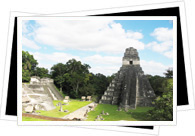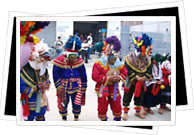
The history of Guatemalan theatre dates back to precolumbian Maya times.
Although historians suspect that the history of theatre in Guatemala probably dates back to the Olmecs, there has been proof found to clarify it.
For the Maya of Guatemala, theatre was part of their religious ceremonies along with dancing and magic.
Many hidden meanings and connotations were included within the performance which were not understood by the Europeans, despite their best efforts to learn the native languages.
The first Europeans in Latin America who recorded the lives of the Amerindians noted that comedies and farces would take place on stone stages. Much of the Maya religious history would be acted out too.
In the remote Guatemalan village of San Pablo de Rabinal, a story believed to have been acted out since the 1200's was narrated by a native to a parish priest in 1855. Although it was later acted out for the priest, the priest only recorded the dialogue.

Even after colonialization, the story was passed through the generations as a piece of theatre, rather than recorded in writing. The piece, Rabinal Achí, is still performed in the village each January and in 1995 UNESCO recognized the dramatical dance as a 'Masterpiece of the Oral and Intangible Heritage of Humanity'. It is the only complete native drama which was saved in the European conquest of the Americas.
Loas del Diablo (scenes of the devil) were some of the most commonly performed pieces at the time of colonialization in Guatemala. Theatre proved to be a good way to communicate Christianity to the natives showing the devil to tempt the Christians away from doing and being good.
Theatre in Guatemala escaped the confines of church and religious performance pieces in the 1820's, following independence from Spain. The then Guatemala government had 3 theatres built, justifying the building work as a way to stop alcoholic tendencies of the capital's population.
The 1840's saw the construction of the Teatro Colón, initially called the National Theatre. It was initially built to bring Italian opera to Guatemala and flourished as the country's main theatre until an earthquake destroyed the building in 1917.
The Renaissance Theatre, across from where the Colón had been, The Teatro Abril, built to replace the Teatro Colón and the Teatro Variades sparked Guatemala's interest in theatre as we know it in the 1920's. The state invested funds into the Guatemala theatre too, but the depression at the end of the decade brought this to an abrupt end.
Government dictator, Jorge Ubico banned international theatre groups from visiting the country. The middle of the next decade slowly saw restrictions lift, financial incentives to return and Guatemalan playwrights encouraged.
By the mid 1940's, with the fall of Ubico, there was evident social progress in Guatemala. Theatre still remains to this day overlooked by the government, however the performances seen are far closer to modern theatre than they ever had been before.